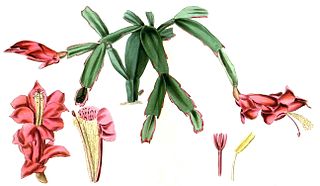
Schlumbergera truncata, the false Christmas cactus, is a species of plant in the family Cactaceae. It is endemic to a small area of the coastal mountains of south-eastern Brazil where its natural habitats are subtropical or tropical moist forests. It is the parent or one of the parents of the houseplants called Christmas cactus, Thanksgiving cactus or zygocactus, among other names.

Weingartia is a genus in the family Cactaceae, with species native to Bolivia and Argentina.

Selenicereus undatus, the white-fleshed pitahaya, is a species of Cactaceae and is the most cultivated species in the genus. It is used both as an ornamental vine and as a fruit crop - the pitahaya or dragon fruit. The native origin of the species has never been resolved.

Disocactus crenatus, the crenate orchid cactus, is a species of cactus and one of the most important parents in creating the epiphyllum hybrids commonly cultivated throughout the world. It is cultivated for its large white flowers.
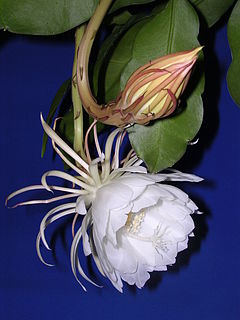
Epiphyllum oxypetalum, the Dutchman's pipe cactus, princess of the night or queen of the night, is a species of cactus. It rarely blooms and only at night, and its flowers wilt before dawn. Though it is sometimes referred to as a night-blooming cereus, it is not closely related to any of the species in the tribe Cereeae, such as Selenicereus, that are more commonly known as night-blooming cereus. All Cereus species bloom at night and are terrestrial plants; Epiphyllum species are usually epiphytic.
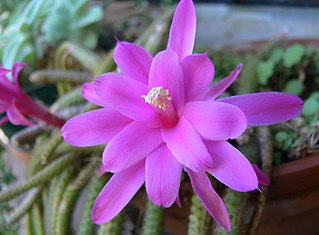
Aporocactus flagelliformis, the rattail cactus, is a species of flowering plant in the cactus family Cactaceae, and is the most cultivated species in the genus Aporocactus. Due to its ease of cultivation and attractive floral displays, it is often grown as an ornamental potted plant.

Disocactus phyllanthoides, the nopalxochitl or German empress, is a species of flowering plant in the cactus family Cactaceae. It is commonly grown as an ornamental houseplant. It is one of the three major species involved in creating the widely grown epiphyllum hybrids or "epis". The others are Disocactus speciosus and Disocactus crenatus.

Selenicereus anthonyanus is a cactus species native to southern Mexico. It is grown as an ornamental because of its nocturnal flowers and unusual, leaf-like stems. Common names include fishbone cactus, rickrack cactus, zig-zag cactus and St. Anthony's rickrack, and is sometimes referred to as an orchid cactus.

Selenicereus spinulosus is a cactus species native to eastern Mexico and, possibly, the lower Rio Grande Valley of Texas in the United States. Common names include vine-like moonlight cactus and spiny moon cereus. Its specific name, spinulosus, means "with small spines" in Latin.

Selenicereus costaricensis, synonym Hylocereus costaricensis, known as the Costa Rican pitahaya or Costa Rica nightblooming cactus, is a cactus species native to Costa Rica, Panama and Nicaragua. The species is grown commercially for its fruit, called pitaya or pitahaya, but is also an impressive ornamental vine with huge flowers. Its scientific name is problematic for several reasons. The species may not be distinct from Selenicereus monacanthus.
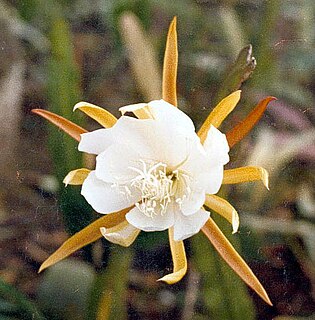
Epiphyllum laui is a cactus species native to Mexico and grown as an ornamental.
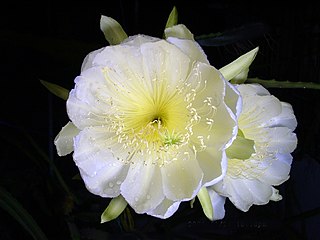
Selenicereus megalanthus, synonym Hylocereus megalanthus, is a cactus species in the genus Selenicereus that is native to northern South America, where it is known, along with its fruit, by the name of pitahaya. The species is grown commercially for its yellow fruit, but is also an impressive ornamental climbing vine with perhaps the largest flowers of all cacti.

Epiphyllum pumilum is a cactus species native to Mexico and Guatemala. The species is commonly grown as an ornamental for its beautiful, fragrant flowers in the summer.
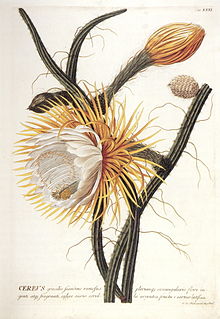
Selenicereus grandiflorus is a cactus species originating from the Antilles, Mexico and Central America. The species is commonly referred to as queen of the night, night-blooming cereus, large-flowered cactus, sweet-scented cactus or vanilla cactus. The true species is extremely rare in cultivation. Most of the plants under this name belong to other species or hybrids. It is often confused with the genus Epiphyllum.

Echinocereus dasyacanthus is a member of the cactus family, Cactaceae. It is one of about 2000 total species belonging to this family. The cactus is commonly known as Texas rainbow cactus because of the subtle rings or bands of contrasting colors along the stem of the plant. Not all Texas rainbow cacti have the "rainbow" coloration on their stems. Another common name is spiny hedgehog cactus.

Echinocereus stramineus is a species of cactus in which stramineus means made of straw. There are various common names such as strawberry cactus, porcupine hedgehog cactus, straw-color hedgehog, and pitaya. The straw-colored spines make this particular plant distinguished from other Echinocereus. The aged spines may turn to white color and are very fragile.
Proatriplex is a monotypic plant genus in the subfamily Chenopodioideae of the family Amaranthaceae, with the only species Proatriplex pleiantha. It is known by the common names four-corners orach and Mancos shadscale. It occurs in the Navajo Basin of Arizona, Colorado, New Mexico, and Utah.
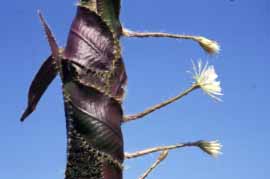
Strophocactus wittii, synonym Selenicereus wittii, known as the Amazon moonflower, is a species of plant in the genus Strophocactus in the cactus family (Cactaceae), and is one of several species commonly called "moonflowers". It was first described in 1900 and is one of three species of cactus found in the central Amazon basin.
Deamia montalvoae is a species of flowering plant in the family Cactaceae, native to southeastern Mexico, Guatemala and El Salvador. It was first described in 2018. It climbs or hangs from trees or rocks, and has large funnel-shaped flowers, mostly white, and pale red fruit, covered with bristles and hairs.
Wachendorfia brachyandra is a small to large, 10–65 cm (3.9–25.6 in) high, winter-growing, perennial herbaceous plant that grows from a rootstock, and has been assigned to the bloodroot family. Its simple, entire, line- to lance-shaped leaves that are usually shorter than the stem, and have pleated, laterally flattened leaf blades af about 35 mm (1.4 in) wide, meaning that there are left and right surfaces rather than upper and lower. The inflorescence is a lax panicle and at the base of each flowerstalk is a dry, brown and papery bract, and those higher in the panicle have a recurved tip. The mirror-symmetrical pale apricot-yellow flowers consist of six tepals and are adorned with brown markings on the upper three tepals. There are three anthers that are clustered and about half as long as the tepals. Each individual flower only lasts one day. Flowering occurs from August to December. This species grows in the wild in the Western Cape province of South Africa only, and is much less common than its relatives W. paniculata and W. thyrsiflora. It is sometimes called short-stamen butterfly-lily in English.

















